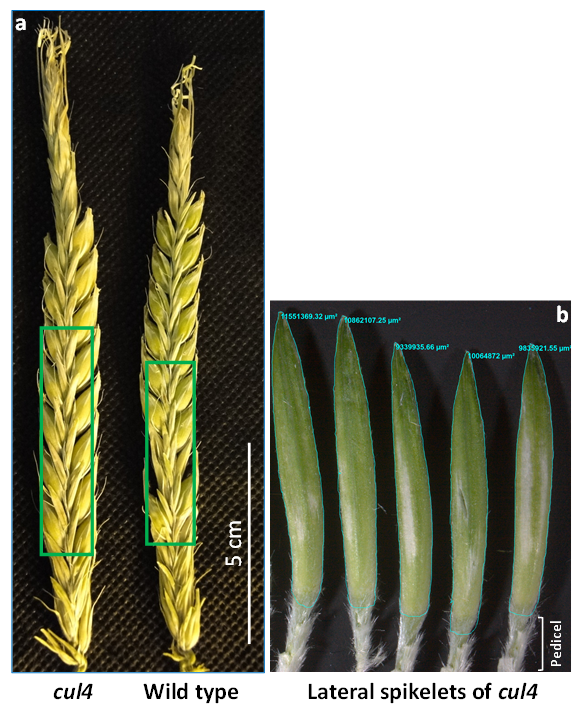Advanced Search
Barley spikelet morphometry analysis
Last updated date: May 11, 2021 Views: 884 Forks: 0
Barley spikelet morphometry analysis
Ravi Koppolu ORCID 0000-0001-8566-9501
Leibniz Institute of Plant Genetics and Crop Plant Research (IPK), Corrensstr. 3, OT Gatersleben 06466 Seeland, Germany
Correspondance to koppolu@ipk-gatersleben.de and schnurbusch@ipk-gatersleben.de
The lateral spikelet morphometry analysis was conducted for the barley dense and erect panicle 1 (dep1) mutant alleles, BW-ari-e.1, BW-ari-e.GP, ari-e.119, their respective wild type progenitors Bowman (BW-ari-e.1, BW-ari-e.GP) and Foma (ari-e.119). Similarly, the lateral spikelet morphometry analysis was conducted for barley uniculm 4 (cul4) mutants cul4.24 (wild type – Flare), and BW-cul4.5 (wild type – Bowman) and RNA guided endonuclease knockout (RGEN KOs) lines of barley SPL14 and azygous Golden Promise. Based on our transcriptomic and phenotypic analyses, we found that wild-type CUL4 and SPL14 act as negative regulators of barley lateral spikelet development (Thiel et al. 2021). However, in the mutants of cul4, the lateral spikelet development is promoted (increase in the size of floral organs such as lemma, palea, stamens, and carpels; Thiel et al. 2021), including awn elongation and grain development in the lateral spikelets of barley SPL14 RGEN KOs (Thiel et al. 2021). Our transcriptomic and phenotypic analysis revealed barley DEP1 as a positive regulator of lateral spikelet development, while the mutants of dep1 showed a reduction in lateral spikelet size (Thiel et al. 2021). To analyze the developmental promotion and growth of lateral spikelets in cul4 mutants and reduction in the lateral spikelet size of dep1 mutants, we quantified the morphometry parameters, such as spikelet length, width, and area by imaging and analysis of lateral spikelets in the respective mutants and their wild type progenitors. In general, the grain morphometry parameters in cereals can be assessed by digital Marvin seed analyzer (GTA Sensorik GmbH, Neubrandenburg, Germany). However, the lateral spikelets of both wild-type and mutants of cul4 and dep1 do not set grains, making it not possible to analyze these parameters using Marvin. Hence, an image analysis method was used to extract lateral spikelet morphometry parameters of cul4, and dep1 mutants. The step-by-step procedure followed for this analysis is described below.
- Harvest green spikes from the main culm after completion of grain filling and onset of senescence (senescence of spikelet starts at the tip and is indicative of growth completion)
- Excise lateral spikelets from the well-developed portion of the spike using forceps (boxed area in the fig. 1a; in our study we analyzed lateral spikelets from spikelet nodes 8 to 17 [(base to top); 10 lateral spikelets]
- Image the excised lateral spikelets under a stereomicroscope (Zeiss Stemi-2000) using appropriate magnification and scaling factors.
- Import the acquired images into Axiovision image analysis software (Zeiss Microscopy GmbH)
- From the measure tab of Axiovision, select the outline option, and draw contours of the spikelets (fig.1b). To conclude the contour, click the right mouse button. The contour can be adjusted by dragging the correction points spread across the contour.
- Select the “create data table” option from the measure tab to export the contour information such as area (µm2), bound width (µm), and bound height (µm).
- Compare the lateral spikelet area, height, and width, in respective mutant and wild type pairs and conduct a significance test with two-tailed Students t-test in MS-office Excel.
The central spikelet morphometry parameters such as length, width, and area were also analyzed for dep1, cul4 mutants, and their respective wild types. Since the central spikelets set grains in both wild type and mutant spikes of dep1, and cul4, we acquired the quantification data using the Marvin seed analyzer.
Note: the barley lateral spikelets are pedicellated. While excising the lateral spikelets using forceps, it is possible to damage part of the pedicel or a portion of the pedicel is still attached to the main spike after lateral spikelet excision. For this reason, we excluded pedicel while drawing contours of lateral spikelets (fig. 1b). The glumes of lateral spikelets were clipped off before imaging.

Figure 1. Lateral spikelet morphometry analysis
(a) Representative spikes of cul4 mutant and wild type. The boxed area in green indicates the area from where the lateral spikelets are excised for imaging and morphometry analysis. (b) lateral spikelets with contours drawn around the spikelets.
- Koppolu, R(2021). Barley spikelet morphometry analysis. Bio-protocol Preprint. bio-protocol.org/prep1075.
- Thiel, J., Koppolu, R., Trautewig, C., Hertig, C., Kale, S. M., Erbe, S., Mascher, M., Himmelbach, A., Rutten, T., Esteban, E., Pasha, A., Kumlehn, J., Provart, N. J., Vanderauwera, S., Frohberg, C. and Schnurbusch, T.(2021). Transcriptional landscapes of floral meristems in barley. Science Advances 7(18). DOI: 10.1126/sciadv.abf0832
Do you have any questions about this protocol?
Post your question to gather feedback from the community. We will also invite the authors of this article to respond.
Share
Bluesky
X
Copy link
